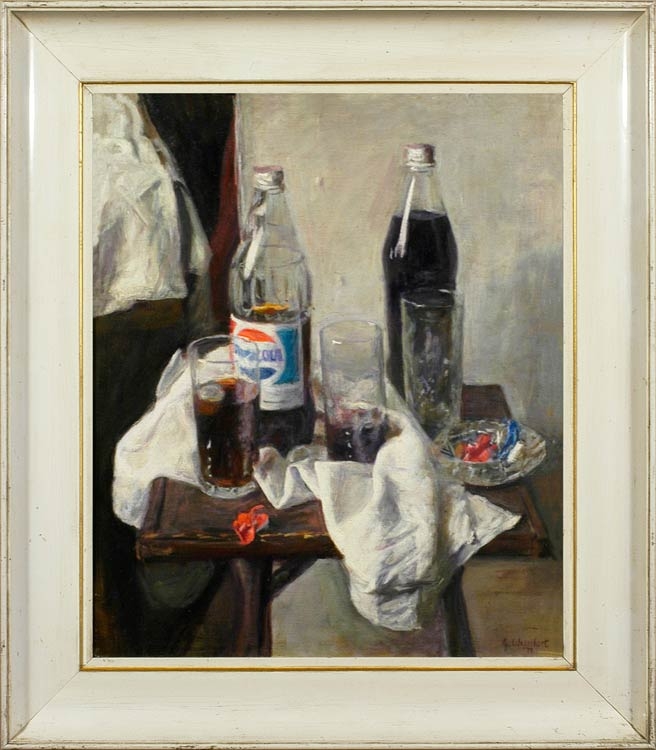Ephemera, wrappings and the detritus of everyday life have always been of interest to artists, as a symbolic obverse of the usually beautiful objects found in still life paintings. Velasquez and Chardin both elevated common household articles – pottery pans, rush baskets, linen, brass and wooden implements – to equality with silver, porcelain and silk brocade; and modern throwaway items are as much the subjects of still life paintings as their grander cousins. Stephen Rose (q.v), for instance, manages to heroicize the clear supermarket plastic bag and the rigid plastic container into artifacts of transcendant beauty; and here Weissbort replaces the mussel, shrimp and oyster shells found in a Hubert de Bellis (q.v.), and the glass bottle or decanter, china cup, napkin and empty plate (see E.P. Berne Bellecour, The remains of the meal, 1876, Chrysler Museum of Art) with plastic Pepsi bottles, cheap glasses and an ashtray of dogends. Undercutting the relentlessly downbeat air of these objects are the colour harmonies of the composition, in which shades of pearl grey, dark cool browns and touches of soft blues and reds echo and re-echo across the painted surface.
Biographical details
George Weissbort (1928-2013) was born in Belgium and moved to London at the age of 7. He attended the Central School of Art & Design (now St Martin’s) where he was taught by Ruskin Spear and Rodrigo Moynihan. He was influenced by Arthur Segal to move from the abstract expressionism of the 1940s to realism, and by Bernard Meninsky, who taught life drawing at the Central School, to study the Old Masters. He turned first to artists such as Cézanne and Matisse, and later to Vermeer, Chardin, Velasquez, Corot, Titian, Holbein, and Piero della Francesca, amongst others.
He exhibited regularly at the Royal Academy, the Royal Society of Portrait Painters and the Fine Art Society. In 1964-65 he had a large exhibition in Paris, and in 2006 he had a one-man retrospective at the Chambers Gallery, London, followed in 2008 by another at the Denise Yapp Gallery, Whitebrook, Monmouth.
He wrote essays on art and criticism which look both at the techniques of making a painting, and of appreciating a work of art. The latter skill he believed came only after years of consciously training the eye to see as the artist saw, considering for example the ‘negative’ spaces around and between objects. He also discussed the work of specific artists, such as Lucien Freud and Vermeer.
His obituary in The Independent quotes Brian Sewell, a friend, as saying of him that Weissbort ‘painted the right pictures at the wrong time’. His appeal was to those who understood his models and influences; he could be described as a painter’s painter, and the same obituary quotes Paula Rego describing him as ‘a truly honest artist who knows so much about painting’.
Publications: George Weissbort, Paintings and Drawings (Parnassus, 2008), ill. 130 colour plates; includes transcripts of a filmed interview; essays by Tony Rudolph, David Lee and Bernard Dunstan RA.
YouTube video: A tribute to George Weissbort by John French.


